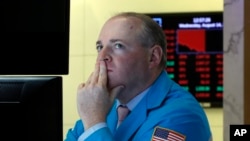Stock markets in Japan fell Thursday, but not as drastically as the plummets experienced by U.S. markets a day earlier that amplified recession fears.
Tokyo's Nikkei index closed down 1.2% Thursday. Elsewhere in Asia, China's Shanghai Composite Index finished up 0.3% and Hong Kong's Hang Seng was up 0.8%, while markets in Europe also showed small gains in early trading after sharp declines on Wednesday.
U.S. market futures pointed to slight gains Thursday, rebounding from Wednesday’s trading that sent the Dow Jones Industrial Average, Standard and Poors 500 and Nasdaq all down 3%.
Yield-curve inversion
Analysts pointed to weak German and Chinese economic data as warning signs of a possible world economic slowdown. But most importantly, the analysts pointed to a so-called yield curve inversion for interest rates on two- and 10-year U.S. Treasury notes.
Typically, interest rates on government bonds held for a long time are higher than those held for shorter periods.
But the reverse was in effect Wednesday, and the analysts see it as a sign that investors have worries about the immediate state of the U.S. economy.
It was the first time such an interest rate inversion had occurred since 2007, at the start of the U.S. recession that was the country's worst economic downturn since the Great Depression of the 1930s.
Millions of U.S. workers lost their jobs in the recession a decade ago, as well as their homes, when they no longer had enough money to make monthly loan payments.
The bond interest rate inversion has preceded the last nine U.S. recessions over the last six decades, although the barometer is not a perfect indicator. No recession occurred in 1966, even though there had been an inversion.
China, Germany weaken
Meanwhile, China said its factory production was the weakest in 17 years, while Germany, Europe's most powerful economic engine, said its economic output shrank in the April-to-June period by one-tenth of a percentage point.
The negative economic indicators could push central banks around the world to cut their key interest rates, following U.S. Federal Reserve policymakers who last month trimmed the key U.S. benchmark rate by one-quarter of a percentage point.
U.S. President Donald Trump blamed Wednesday's economic news on the fed, tweeting:
Trump, who has touted a robust U.S. economy as a key reason voters should re-elect him in 2020, has frequently criticized the independent Federal Reserve Board for not cutting interest rates fast enough.











